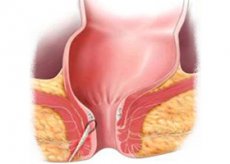Medical expert of the article
New publications
Anorectal fistula (rectal fistula)
Last reviewed: 05.07.2025

All iLive content is medically reviewed or fact checked to ensure as much factual accuracy as possible.
We have strict sourcing guidelines and only link to reputable media sites, academic research institutions and, whenever possible, medically peer reviewed studies. Note that the numbers in parentheses ([1], [2], etc.) are clickable links to these studies.
If you feel that any of our content is inaccurate, out-of-date, or otherwise questionable, please select it and press Ctrl + Enter.

An anorectal fistula is a tubular passage that opens on one side into the anal canal and on the skin in the perianal area with the other opening. Symptoms of anorectal fistulas include discharge from the fistula and sometimes pain. Diagnosis is made by examination and sigmoidoscopy. Treatment of anorectal fistulas often requires surgery.
What causes anorectal fistulas?
Anorectal fistulas occur spontaneously or develop secondary to drainage of a perirectal abscess. Predisposing factors include Crohn's disease and tuberculosis. Most fistulas involve the anorectal crypt; others may result from diverticulitis, tumor, or trauma. In infants, fistulas are congenital and are more common in boys. Rectovaginal fistulas may be secondary to Crohn's disease, obstetric injury, radiation therapy, or malignancy.
Symptoms of anorectal fistulas
A history of recurrent abscesses is typical, accompanied by periodic or constant discharge from the fistula. The discharge is usually purulent, serous-hemorrhagic or mixed. If infection is present, pain may be observed.
Diagnosis of anorectal fistulas
On examination, one or more secondary fistula openings may be found. A cord-shaped fistula tract is often palpated. Examination with a probe inserted into the fistula tract allows the depth, direction, and often the primary fistula opening to be determined. Sigmoidoscopy may be used. Cryptogenic fistulas should be differentiated from purulent hidradenitis, epithelial coccygeal fistula, pustular skin lesions, and urethral-perianal fistulas.
What do need to examine?
How to examine?
Treatment of anorectal fistulas
Previously, the only effective treatment for anorectal fistulas was surgical, which involved primary opening of the entire fistula, excision, and formation of a "groove." Partial sphincterotomy is necessary. If a significant portion of the sphincter is dissected, some fecal incontinence may develop. In the presence of diarrhea or Crohn's disease, fistulotomy is inappropriate due to the long healing time of the wound. In Crohn's disease, patients should be prescribed metronidazole and other appropriate antibiotics, as well as suppressive therapy. Infliximab is very effective for fistulas due to Crohn's disease. Transfer of flaps or instillation of fibrin glue into the fistula tract are alternatives to conventional surgery.


 [
[